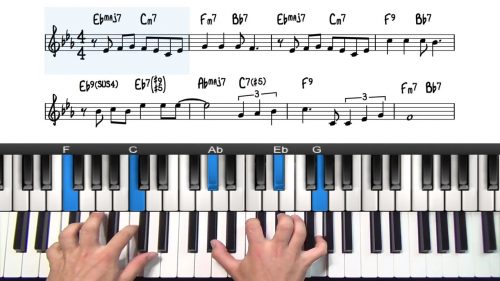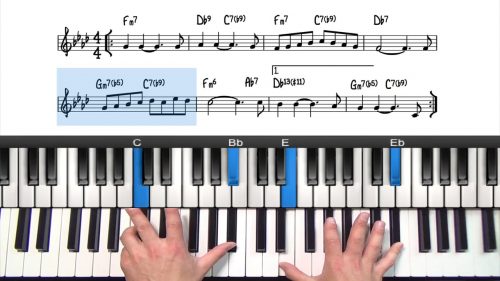Secondary Dominant Chords In Jazz Piano
In this 5 minute masterclass we’re going talk about the second scale degree dominant, the 5 of 5, and it’s different functions. I wanted to do a short masterclass about this topic just because this very common harmonic movement keeps coming up in almost all the other courses, and I want to make sure everyone understands what it means.
The Secondary Dominant Chord Progression
In the key of C, we have the dominant G7 to Cmaj. The 5 of 5 is simply a dominant to that 5 chord, so D7 going to G7, resolving to Cmaj7. (Notice also that it is still a 2-5-1, even if the D is a dominant chord instead of a minor Chord)
Descending b3 Diminished Progression
We will look at the function of the descending b3 diminished chord in a situation like Em7 – Ebdim7 – Dm7 – G7 and discover how it relates to a secondary dominant. At first glance, the Ebdim7 doesn’t appear to have a clear dominant function to the Dm7 but, looking closer, the Ebdim7 has close ties to D7, the secondary dominant in this progression.
Tune Examples and Improvisation
Secondary dominants are used often in jazz standards and we will look at some examples including “Take the A Train”, “But Not For Me” and “Smoke Gets In Your Eyes”. Approaches to improvisation are also discussed including various possible substitutions and re-harmonisations.
Lesson Downloads
-
Secondary Dominant Lesson Notation File Type: pdf
Practice Tips
-
Identify secondary dominants and their variations in tunes that you know and when you learn new songs.
-
Practice using a secondary dominant as a substitution for a regular 2-5-1, in tunes where the melody allows and when improvising.
-
Improvise on a tune, using one of the secondary dominant variations as a substitution for every 2-5 progression in the tune.








Thank you Tuomo, for explaining this so clearly. It’s very useful for me. All the best :)
Thank You Natasha, let me know if I can help with anything else!
-Tuomo
Hi Tuomo, I am interested in the use of the b3rd Diminished. As I understand it, the V of G7 is D7, and if a b9 is added, it becomes D7b9, and has the same notes as Ebdim7. But if the left hand root note drops down a half-step, is it still considered a Secondary Dominant, even though now it is a Diminished 7 ?
I also noticed that the b3rd is actually a minor 3rd above the I chord, that is pretty cool.
I am trying to learn as much as I can about jazz harmony to help with my composition.
Best wishes, Natasha
Hi Natasha, thanks for writing!
As I mentioned in the video, Ebdim is the same chord as D7 (with b9 of course), just with a different bass note.
Always with chords, try to detect the function behind it instead of looking just the notes. Main notes in a chord are 3 and 7, root is not that important when we are looking at the harmony from the perspective of where it is leading to/where it is coming from.
Good example of this is the tritone sub (let me know if you’re not familiar with this);
V to C is G7, and tritone sub V is Db7. If you take the 3 and 7 of G7, and instead of G you play Db as the root, it turns into Db7 (check attachment).
Great that you noticed that the root is also b3 away from Eb! And of course as we know that diminished is symmetrical, always the same in b3rds, which MEANS that Ebdim is also a Cdim (and also Adim and F#dim!), check the attachment.
This opens a whole new topic in harmony!
Question for you: Can you tell me which V chords are behind this diminished (Eb, C, A or F#dim)?
Hi Tuomo, thank you for the attachment. In answer to your question, that would be the diminished whole-half scale beginning on C, and the V chords in that would be : D7, F7, Ab7, and B7 ? Is that correct ?
You mention ” the function behind a chord” — is that to do with movement, or tension or resolution, things like that ?
Many thanks
Correct answer!
First to your question, when I talked about function behind the chord, I meant that we need to understand that music is just tension and release, meaning V – I (or II V I of course). In a core level, in harmony we just have something that is a tension and where it resolves to.
That’s why I mentioned the important notes of the chords are only 3 and 7, as those really define the quality of the chord; whether it’s minor7, minor major 7, dominant 7 or major 7. All other notes we have in chords are there just to bring color and make the movement more interesting, but remember, they are just extra, not the main thing!
Now to the diminished. You found the dominants behind the Ebdim chord, which we already saw is also Cdim (also Adim and F#dim). So here a new way of looking at this:
As we learned in the video, Ebdim moving to D-7 G7 is actually a D7 chord moving to G7, D-7 is there just for color. Now there is a common harmonic concept that I call ‘I-diminished’, or ‘tonic diminished’, that resolves into I maj, here in C (attachment):
Now, we see the SAME Ebdim (Cdim) in the same key is resolving to a totally different chord that the earlier D7. Why this sounds good? Reason is in the dominants you mentioned earlier;
If we first look at Cmaj7, we see that it is pretty much the same thing as E-7, the 3rd degree of the Cmajor scale (remember, you can always swap the 1st, 3rd and the 6th degree in major (in Cmaj it would be Cmaj, E-7 and A-7), they are a good and simple way to reharmonize when composing, but. that’s another topic).
The notes are the same in both chords (check attachment).
Now, one of the dominants you mentioned earlier is B7, the dominant to E! This is the reason why Cdim -> Cmaj sounds natural, it’s actually just B7 (V) to E-7 (I). Again check the attachment.
Let me know if you have any further questions, or if I can help further with this or with any other topic!
Keep up the good work!
-T
Sorry, here the attachment
Hi Tuomo, I have been working on this, and am understanding it better than before, I just have one more question : in the progression Em7, Ebdim7, Dm7 etc, is the Em 7 considered to be a 1 chord, because it has the same notes as C Major, OR is it considered to be a ii chord as it leads to the Ebdim 7 which is now a V chord?
Could you clarify this for me ? Many thanks
Natasha
Hi Natasha, yes you can think of it as a 1 chord, in this case the basic ‘core’ cadence would be Cmaj – D7 – G7 (check attachment), based on the ground functions of these chords have (explained previously).
If you want to think of the Ebdim as a dominant (D7), then you can also harmonize the E-7 with A-7, as that would be the 2 chord of the A-7 D7 25 (as mentioned previously)
You can also think of the E- as a II chord, in that case you can reharmonize the Ebdim with A7, as then the E- would have more functionality as a II chord, after all point is to resolve musically to the next chord, and both Edim and A7 will do it great.
The point is, we have million different ways how to think of these movements in harmony. I would try to understand these through listening where the music is heading, and what the function of each chord has from the perspective how it sounds.
Thanks, let me know if you have any further questions.